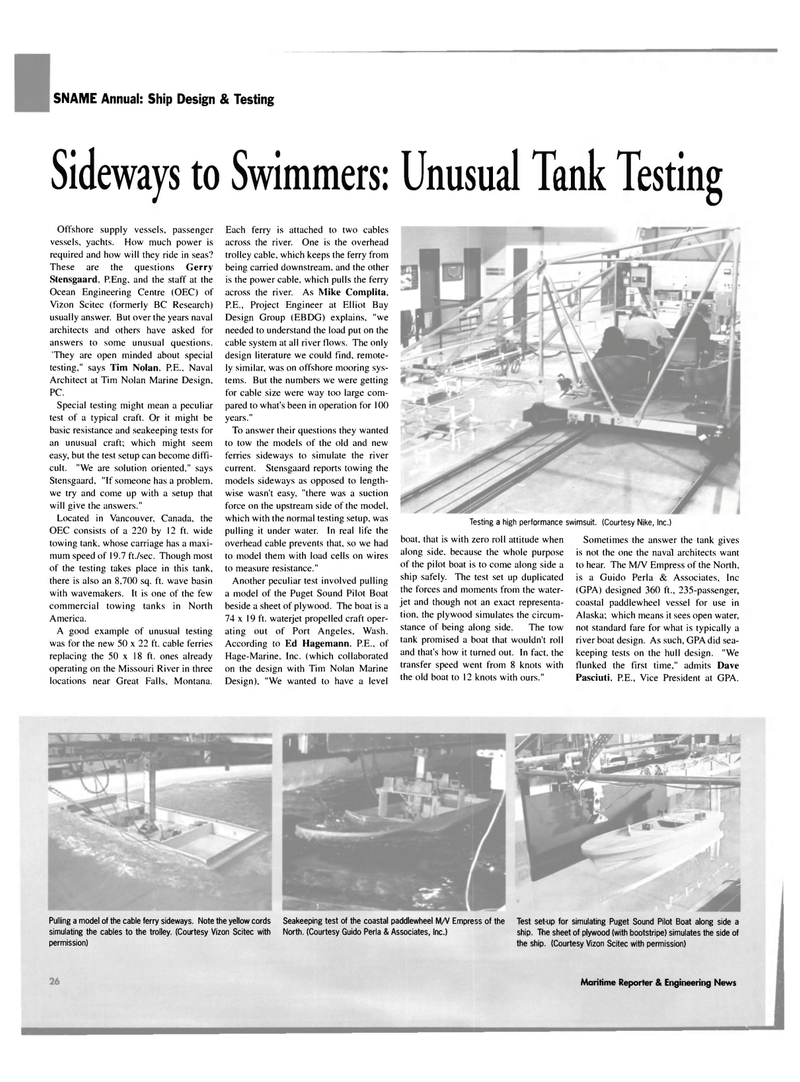
Page 27: of Maritime Reporter Magazine (September 2004)
Marine Propulsion Annual
Read this page in Pdf, Flash or Html5 edition of September 2004 Maritime Reporter Magazine
SNAME Annual: Ship Design & Testing
Sideways to Swimmers: Unusual Tank Testing
Offshore supply vessels, passenger vessels, yachts. How much power is required and how will they ride in seas?
These are the questions Gerry
Stensgaard, P.Eng, and the staff at the
Ocean Engineering Centre (OEC) of
Vizon Scitec (formerly BC Research) usually answer. But over the years naval architects and others have asked for answers to some unusual questions. "They are open minded about special testing," says Tim Nolan. P.E., Naval
Architect at Tim Nolan Marine Design,
PC.
Special testing might mean a peculiar test of a typical craft. Or it might be basic resistance and seakeeping tests for an unusual craft; which might seem easy, but the test setup can become diffi- cult. "We are solution oriented," says
Stensgaard, "If someone has a problem, we try and come up with a setup that will give the answers."
Located in Vancouver, Canada, the
OEC consists of a 220 by 12 ft. wide towing tank, whose carriage has a maxi- mum speed of 19.7 ft./sec. Though most of the testing takes place in this tank, there is also an 8,700 sq. ft. wave basin with wavemakers. It is one of the few commercial towing tanks in North
America.
A good example of unusual testing was for the new 50 x 22 ft. cable ferries replacing the 50 x 18 ft. ones already operating on the Missouri River in three locations near Great Falls, Montana.
Each ferry is attached to two cables across the river. One is the overhead trolley cable, which keeps the ferry from being carried downstream, and the other is the power cable, which pulls the ferry across the river. As Mike Complita.
P.E., Project Engineer at Elliot Bay
Design Group (EBDG) explains, "we needed to understand the load put on the cable system at all river flows. The only design literature we could find, remote- ly similar, was on offshore mooring sys- tems. But the numbers we were getting for cable size were way too large com- pared to what's been in operation for 100 years."
To answer their questions they wanted to tow the models of the old and new ferries sideways to simulate the river current. Stensgaard reports towing the models sideways as opposed to length- wise wasn't easy, "there was a suction force on the upstream side of the model, which with the normal testing setup, was pulling it under water. In real life the overhead cable prevents that, so we had to model them with load cells on wires to measure resistance."
Another peculiar test involved pulling a model of the Puget Sound Pilot Boat beside a sheet of plywood. The boat is a 74 x 19 ft. waterjet propelled craft oper- ating out of Port Angeles, Wash.
According to Ed Hagemann. P.E., of
Hage-Marine, Inc. (which collaborated on the design with Tim Nolan Marine
Design), "We wanted to have a level boat, that is with zero roll attitude when along side, because the whole purpose of the pilot boat is to come along side a ship safely. The test set up duplicated the forces and moments from the water- jet and though not an exact representa- tion, the plywood simulates the circum- stance of being along side. The tow tank promised a boat that wouldn't roll and that's how it turned out. In fact, the transfer speed went from 8 knots with the old boat to 12 knots with ours."
Sometimes the answer the tank gives is not the one the naval architects want to hear. The M/V Empress of the North, is a Guido Perla & Associates, Inc (GPA) designed 360 ft., 235-passenger, coastal paddlewheel vessel for use in
Alaska; which means it sees open water, not standard fare for what is typically a river boat design. As such, GPA did sea- keeping tests on the hull design. "We flunked the first time," admits Dave
Pasciuti, P.E., Vice President at GPA.
Maritime Reporter & Engineering News
Pulling a model of the cable ferry sideways. Note the yellow cords simulating the cables to the trolley. (Courtesy Vizon Scitec with permission)
Seakeeping test of the coastal paddlewheel M/V Empress of the
North. (Courtesy Guido Perla & Associates, Inc.)
Test set-up for simulating Puget Sound Pilot Boat along side a ship. The sheet of plywood (with bootstripe) simulates the side of the ship. (Courtesy Vizon Scitec with permission)
Testing a high performance swimsuit. (Courtesy Nike, Inc.)

 26
26

 28
28
